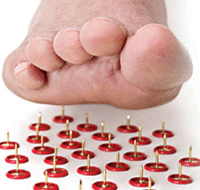Health Topics
-
Healthy Living
-
|
|
September 2009
|
| 12 Tips to Take Care of Diabetic Foot |
| Dr. Tirthankar Chaudhury |
| |
 |
A large number of diabetic patients suffer from some form of foot ulcers at some point of time. When neglected, these progress to dire consequences. Over time diabetes damages the nerves, giving rise to a condition called peripheral neuropathy. |
|
| It diminishes the ability of a person to sense the pain or sores, making small injuries go unnoticed, aggravating it. Diabetes can also result in the clogging of many peripheral arteries, which reduces the blood supply to the legs, making feet prone to infection and gangrene. Poor control of diabetes makes the connective tissue fragile and damages the complicated foot architecture. |
Things to watch out for
- Altered sensation in your foot
- Burning sensation
- Walking impairment, like cramping
- Feet suddenly turning cold without joint swelling
- Edema or swelling of feet
- Excess fatigue
- Pain in leg even in rest
- Any open wound, cuts, bruise or unusual marks
- Any change in skin colour or texture of feet
- Any change in nail area
- Sensation of vibration or tingling
Newer Dressings & Ulcer healing options
- Platelet Derived Growth Factor
- Hyaff- a chemical that promotes healing
- Apligraf- a combination of living cells and structured protein
- Dermagraft- Bivengineered human dermis or skin layer
|
| Reduce the pressure on the affected leg and keep the foot elevated. |
Take time to inspect your feet. Look for cracks, calluses, disfigured nails. Look in the web spaces space in between two fingers. Use a mirror to inspect the soles. If possible, have someone inspect them for you. |
| Take care of continuous maintenance of sterile, nonadhered dressing. If wet or blood-soaked, it must be changed immediately. |
Walking barefooted is not a very good idea for you as it makes your feet more vulnerable to injury and makes an easy entry site for germs. |
| If reduced blood supply is the cause of foot ulcer, an intervention or surgery may be considered to improve the circulation. A very good control of your diabetes is the key point. The target of treatment is to prevent blood sugar fluctuations as much as possible. Ask your doctor about your ideal sugar level and work out to maintain it as much as possible. |
Always use comfortable footwear. An ideal shoe should be comfortably and snugly fit and must not put pressure on the toes. Change your shoes at regular intervals and avoid using damaged or tattered footwear. Tennis shoes and suede shoes are least likely to create foot problems. |
| Never dip your feet in hot water – it may be dangerous. Always use lukewarm water. Clean the web spaces as well. Mop your feet dry including the web spaces. |
Avoid web-strap shoes (like hawai chappal). Your walking shoe should have a wide and roomy toe box and there should be sufficient shock absorbers in the soles. |
| For dry and scaly skin, apply moisturizing lotion or cream and put on cotton socks while retiring to bed at night. Do not leave extra lotion in the web space as it may macerate the skin. |
Depending upon the condition, you will be prescribed antimicrobial agents. An infected ulcer needs aggressive treatment to prevent spreading. If ulcer is wide-spread or deep, it may need a small procedure called debridement, where the infected portion is removed. It is usually an outpatient procedure done under local anesthesia. |
| Always use socks – the thicker, the better. |
Never ignore any of the symptoms and check with your doctor. Treatment of foot ulcer is multidisciplinary and multi pronged. Along with your diabetologist, you may need the expertise of a podiatrist, neurologist, dermatologist, vascular surgeon, cosmetic surgeon, depending upon the extent of the ulcer. |
| Strictly abstain from consuming tobacco in any form. |
|
 |
Dr. Tirthankar Chaudhury is Consultant, Diabetes & Endocrinology at Apollo Gleneagles Hospitals, Kolkata |
|
|